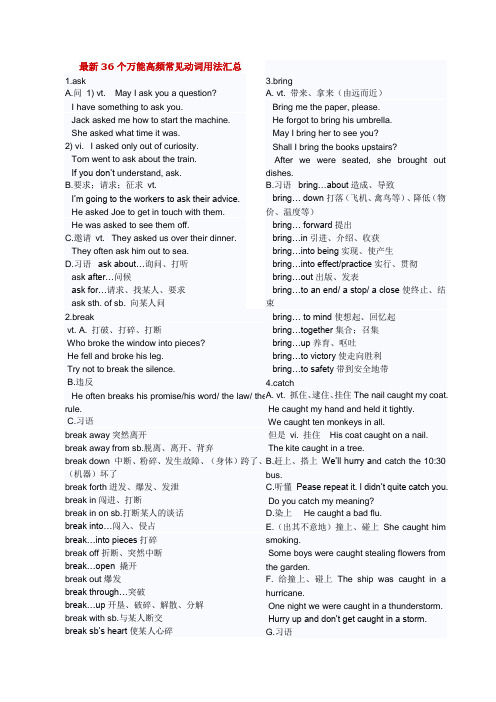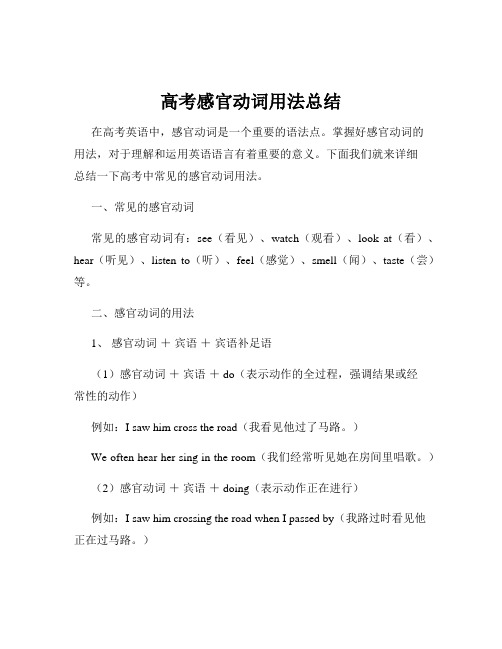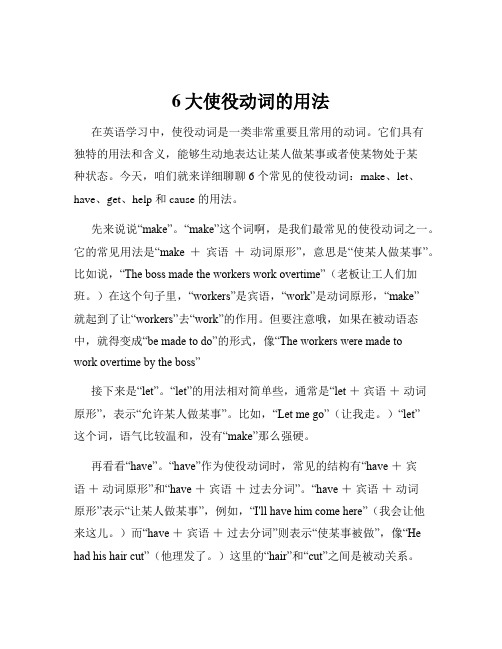常见动词的用法
- 格式:docx
- 大小:12.64 KB
- 文档页数:3

动词动词的五种基本形式及其用法动词是语言中最基本的成分之一,用来表示动作、状态、存在等。
根据使用的时态和语态,动词可以分为五种基本形式:原形、第三人称单数形式、过去式、过去分词和现在分词。
每种形式在句子结构中发挥着不同的作用和用法。
本文将详细介绍这五种形式及其常见用法。
一、原形动词的原形即词典中所列的动词的基本形式。
原形通常在句子中作为谓语动词,表示主语所进行的动作或状态。
此外,原形还可以用作不定式,构成不定式短语,用于表示动作目的、结果、条件或方式等。
同时,在条件句或感叹句中,原形也可以作为情态动词的补充。
示例:1. He runs every morning.(原形作为谓语动词)2. She needs to study for the exam.(原形作为不定式短语的一部分)二、第三人称单数形式第三人称单数形式是指动词在第三人称主语(如he、she、it)下的特殊形式。
它通常在句子中作为谓语动词,表示第三人称主语所进行的动作或状态。
示例:1. She sings beautifully.(第三人称单数形式作为谓语动词)2. The cat sleeps all day.(第三人称单数形式作为谓语动词)三、过去式过去式是动词的过去时态形式,用于表示过去发生的动作或存在的状态。
它可以在句子中作为谓语动词,也可以用作形容词或名词的修饰成分,表示描述过去的定语或定语从句。
示例:1. I played soccer yesterday.(过去式作为谓语动词)2. The broken vase was a gift from my grandmother.(过去式作为形容词修饰成分)四、过去分词过去分词是动词的一种非限定形式,通常用于完成时态和被动语态。
在完成时态中,过去分词与助动词have或has连用,表示动作已经完成。
在被动语态中,过去分词与be动词连用,表示主语受到动作的影响。
示例:1. She has written a novel.(过去分词用于完成时态)2. The car was repaired by a mechanic.(过去分词用于被动语态)五、现在分词现在分词是动词的一种非限定形式,通常以-ing结尾,用于进行时态、形容词和副词的修饰成分,以及分词短语的构成。

最新36个万能高频常见动词用法汇总1.askA.问 1) vt. May I ask you a question? I have something to ask you.Jack asked me how to start the machine. She asked what time it was.2) vi. I asked only out of curiosity. Tom went to ask about the train. If you don’t understand, ask. B.要求;请求;征求 vt.I’m going to the workers to ask their advice. He asked Joe to get in touch with them. He was asked to see them off.C.邀请 vt. They asked us over their dinner. They often ask him out to sea.D.习语 ask about…询问、打听 as k after…问候ask for…请求、找某人、要求 ask sth. of sb. 向某人问 2.breakvt. A. 打破、打碎、打断Who broke the window into pieces? He fell and broke his leg. Try not to break the silence. B.违反He often breaks his promise/his word/ the law/ therule. C.习语 break away 突然离开 break away from sb.脱离、离开、背弃 break down 中断、粉碎、发生故障、(身体)跨了、(机器)坏了 break forth 迸发、爆发、发泄 break in 闯进、打断 break in on sb.打断某人的谈话 break into…闯入、侵占 break…into pieces 打碎 break off 折断、突然中断 break…open 撬开 break out 爆发break through…突破break…up 开垦、破碎、解散、分解 break with sb.与某人断交 break sb’s heart 使某人心碎3.bringA. vt. 带来、拿来(由远而近)Bring me the paper, please. He forgot to bring his umbrella. May I bring her to see you?Shall I bring the books upstairs?After we were seated, she brought out dishes.B.习语 bring…about 造成、导致 bring… down 打落(飞机、禽鸟等)、降低(物价、温度等)bring… forward 提出bring…in 引进、介绍、收获 bring…into being 实现、使产生bring…into effect/practice 实行、贯彻 bring…out 出版、发表bring…to an end/ a stop/ a close 使终止、结束bring… to mind 使想起、回忆起 bring…together 集合;召集 bring…up 养育、呕吐bring…to victory 使走向胜利 bring…to safety 带到安全地带4.catchA. vt. 抓住、逮住、挂住The nail caught my coat. He caught my hand and held it tightly.We caught ten monkeys in all. 但是 vi. 挂住 His coat caught on a nail. The kite caught in a tree. B.赶上、搭上 We’ll hurry a nd catch the 10:30 bus. C.听懂 Pease repeat it. I didn’t quite catch you. Do you catch my meaning? D.染上 He caught a bad flu. E.(出其不意地)撞上、碰上 She caught him smoking.Some boys were caught stealing flowers from the garden.F. 给撞上、碰上 The ship was caught in a hurricane.One night we were caught in a thunderstorm. Hurry up and don’t get caught in a storm. G.习语catch at sth. 想抓住、设法抓住catch sb. by surprise出其不意抓住catch/get/seize/take hold of…(突然)抓住、抓牢catch sb’s attention/eye吸引某人注意catch sight of…看到、发现catch t he point of…抓住…的要点catch up赶上catch up with…赶上…5.doA. aux. v.(1) 帮助构成一般过去时或一般现在时的疑问或否定式They do not believe it. When id they arrive there?(2) 用在肯定句和祈使句中加强语气I do miss you, Mum. She does sing well. Do be on time. So she did come after all.(3) 用来表示前边提到的动作(以免重复)---May I come round in the evening? ---Yes, please do.I knew he would help us, and he did.(4) 用于某些倒装句中Only then did I realize he had been wrong. Never did he know anything about it.B. 做vt. Can I do anything for you?We often do our homework together.The glass is broken. who did it?We did some reading last night.She did most of the talking.C. vi. (1) 表示生活、学习等情况How do you do?They did very well in English but badly in maths.How did you do in the exam? How are you doing?(2) 行了、够了、可以On e piece of bread will do. Talking with your mouth full won’t do.(3) 做、办Do as you are told to.When in Rome, do as the Romans do.Let her do as she likes.D.习语do…with…处理What have you done with my bike? can do with…将就用I can do with the old bed. do something about…对…采取措施do sb. a favor=do a favor for sb.帮某人个忙do away with…废除、破除、去掉do sb. good/harm/wrong= do good/harm/wrong to sb. 对某人有益/有害/冤枉某人do one’s best/ bit/part=do everything/all/what one can尽力do …up包扎、扣(纽扣)do w ithout…没有…也行、不需要have something to do with…与…有关do right/wrong做得对/做错了6.expect1. vt. 期待、预料、等待It’s what we’ve expected. Is this the letter you have been expecting?We expect to finish the work by Friday.I expect that they will drop in.I expect you to make more progress.---Will he be back tonight? ---I expect so.You arrived earlier than we had expected.2.习语as (is/ was/ has been) expected不出所料They came late again, as was expected.expect too much of sb.对某人期待过高7.feel感觉、觉得A. (1) vt Do you feel any pain when I press here?Facing this situation, they felt both joy and fear.(2) link v. I don’t feel very well today.The busier he is, the happier he feels.The desk feels smooth.(3) vt. 接复合宾语I felt someone go upstairs.I felt a great weight taken off my mind after the exam.She felt their eyes watching her when she came to the stage.She felt herself (to be) right.I felt it my duty to help you.He felt it necessary to talk about his own shortcomings.(4) vt. 宾语从句He felt strongly that we should take some action about the bad practice.B. vt. 摸He felt the pot and it felt very hot.C.习语feel like doing sth.想要feel one’s way摸索前进feel sb’s pulse切脉feel as if/ as though感觉似乎She felt as if she were a member of the family. feel quite oneself 觉得身体很好8.findA. vt. (1) 发现I found a wallet on the street corner yesterday. He found her in danger.=He found that she was in danger.I found him (to be) a tough guy.=I found that he was a tough guy.This method was found to be practical.=It was found that the method was practical.I find it interesting to read these stories.= I find that it is interesting to =read these stories.I found a dog killed in the park.= I found that a dog had been killed in the park.I found a man breaking into a warehouse.= I found that a man was breaking into a warehouse.(2) 找到Have you found the book you have been looking for?B.习语find…out查清楚;弄明白;了解;打听find one’s way to sp.设法赶到;进入They found their way to the front of the crowd.The news found its way to a lot of people. find fault with sb. 对某人吹毛求疵;挑剔find oneself…发现自己…、不自觉地…They found themselves in a difficult situation. Then I found myself surrounded by some boys.He found himself walking in the direction to the park.他发现自己不知不觉地在往公园的方向走。

英语动词的用法口诀英语动词是英语学习中的重要部分,掌握其用法对于准确表达意思至关重要。
为了帮助大家更好地理解和运用英语动词,下面为大家总结了一些实用的用法口诀。
一、一般现在时“一般现在时,动词用原形;主语是三单,动词要变形。
”这意味着在一般现在时态中,如果主语不是第三人称单数(如 I、you、we、they 等),动词就使用原形。
但当主语是第三人称单数(he、she、it 或单数名词)时,动词要进行相应的变化,通常是在动词后面加“s”或“es”。
例如:“I play football every day”(我每天踢足球。
)“He plays football every day”(他每天踢足球。
)二、现在进行时“现在进行时,be 加动词 ing;动作正进行,别忘 be 变形。
”现在进行时用于表示正在进行的动作,其结构是“be 动词(am/is/are)+动词的现在分词(ing 形式)”。
同时,要注意 be 动词根据主语的不同进行变化。
比如:“I am reading a book”(我正在读书。
)“They are playing basketball”(他们正在打篮球。
)三、一般过去时“一般过去时,动词加 ed;不规则变化,单独要记清。
”一般过去时表示过去发生的动作或状态,大部分动词在过去时中直接在词尾加“ed”。
但也有很多不规则动词,它们的过去式需要单独记忆,比如“go went”“have had”“eat ate”等。
举个例子:“I played computer games yesterday”(我昨天玩了电脑游戏。
)四、过去进行时“过去进行时,was/were 加 doing;过去某时刻,动作正发生。
”过去进行时强调在过去的某个具体时刻或时间段内正在进行的动作,其结构是“was/were +动词的现在分词”。
例如:“I was watching TV at eight o'clock last night”(昨晚八点我正在看电视。

高考感官动词用法总结在高考英语中,感官动词是一个重要的语法点。
掌握好感官动词的用法,对于理解和运用英语语言有着重要的意义。
下面我们就来详细总结一下高考中常见的感官动词用法。
一、常见的感官动词常见的感官动词有:see(看见)、watch(观看)、look at(看)、hear(听见)、listen to(听)、feel(感觉)、smell(闻)、taste(尝)等。
二、感官动词的用法1、感官动词+宾语+宾语补足语(1)感官动词+宾语+ do(表示动作的全过程,强调结果或经常性的动作)例如:I saw him cross the road(我看见他过了马路。
)We often hear her sing in the room(我们经常听见她在房间里唱歌。
)(2)感官动词+宾语+ doing(表示动作正在进行)例如:I saw him crossing the road when I passed by(我路过时看见他正在过马路。
)I heard her singing in the room at that time(那时我听见她正在房间里唱歌。
)(3)感官动词+宾语+ done(表示宾语与宾语补足语之间是被动关系)例如:I saw the window broken(我看见窗户被打破了。
)We found the tree cut down(我们发现树被砍倒了。
)2、感官动词+宾语从句例如:I saw that he crossed the road safely(我看见他安全地过了马路。
)She heard that someone was knocking at the door(她听见有人在敲门。
)3、感官动词的被动语态感官动词在被动语态中,其后的宾语补足语要用带 to 的不定式。
例如:He was seen to cross the road(有人看见他过了马路。
)The girl was heard to sing in the room(有人听见这个女孩在房间里唱歌。

英语中动词的分类和用法在英语学习中,动词是最为重要和复杂的部分之一。
动词不仅数量众多,而且其分类和用法丰富多样。
掌握动词的分类和用法对于正确理解和运用英语至关重要。
接下来,让我们一起深入探讨英语中动词的分类和用法。
一、动词的分类(一)实义动词实义动词是表示具体动作或状态的动词,具有实际的意义。
例如:“run(跑)”“eat(吃)”“sleep(睡觉)”“love(爱)”等。
实义动词又可以分为及物动词和不及物动词。
及物动词后面需要接宾语才能表达完整的意思。
比如,“I eat an apple”(我吃一个苹果)中的“eat”就是及物动词,“apple”是宾语。
不及物动词则不需要接宾语就能表达完整的意思。
例如,“The bird flies”(鸟儿飞翔)中的“flies”就是不及物动词。
(二)系动词系动词用于连接主语和表语,说明主语的状态、性质、特征等。
常见的系动词有“be(am/is/are/was/were)”“seem(似乎)”“look(看起来)”“feel(感觉)”“sound(听起来)”“taste(尝起来)”“smell(闻起来)”等。
例如,“She is beautiful”(她很漂亮),“The soup tastes delicious”(这汤尝起来很美味)。
(三)助动词助动词主要用于协助主要动词构成各种时态、语态、语气等。
常见的助动词有“do/does/did”“have/has/had”“will/would”“shall/should”“be (am/is/are/was/were/being/been)”等。
例如,“He doesn't like sports”(他不喜欢运动),“We have finished our homework”(我们已经完成了作业)。
(四)情态动词情态动词表示说话人的态度、情感或推测等。
常见的情态动词有“can/could”“may/might”“must”“shall/should”“will/would”“oughtto”“need”“dare”等。

6大使役动词的用法在英语学习中,使役动词是一类非常重要且常用的动词。
它们具有独特的用法和含义,能够生动地表达让某人做某事或者使某物处于某种状态。
今天,咱们就来详细聊聊 6 个常见的使役动词:make、let、have、get、help 和 cause 的用法。
先来说说“make”。
“make”这个词啊,是我们最常见的使役动词之一。
它的常见用法是“make +宾语+动词原形”,意思是“使某人做某事”。
比如说,“The boss made the workers work overtime”(老板让工人们加班。
)在这个句子里,“workers”是宾语,“work”是动词原形,“make”就起到了让“workers”去“work”的作用。
但要注意哦,如果在被动语态中,就得变成“be made to do”的形式,像“The workers were made towork overtime by the boss”接下来是“let”。
“let”的用法相对简单些,通常是“let +宾语+动词原形”,表示“允许某人做某事”。
比如,“Let me go”(让我走。
)“let”这个词,语气比较温和,没有“make”那么强硬。
再看看“have”。
“have”作为使役动词时,常见的结构有“have +宾语+动词原形”和“have +宾语+过去分词”。
“have +宾语+动词原形”表示“让某人做某事”,例如,“I'll have him come here”(我会让他来这儿。
)而“have +宾语+过去分词”则表示“使某事被做”,像“He had his hair cut”(他理发了。
)这里的“hair”和“cut”之间是被动关系。
“get”也是个常用的使役动词。
“get +宾语+动词不定式”,意思是“使某人做某事”,例如,“I got him to help me”(我让他帮助我。
)它还有“get +宾语+现在分词”的用法,表示“使某人或某物处于某种状态”,比如,“The joke got us laughing”(这个笑话让我们大笑起来。
英语动词七种形式的用法动词在英语中有七种形式:原形、第三人称单数形式、现在分词、过去式、过去分词、原形复数形式和现在进行时形式。
每种形式都有不同的用法。
1. 原形(Base Form):指动词的原始形式,即不加任何变化。
如:go(去)、eat(吃)。
-用法:-作为动词的基本形式,用于句子的谓语部分,表示动作或状态。
2. 第三人称单数形式(Third Person Singular Form):是指在动词原形后加上-s、-es或-ies等形式,用来表示第三人称单数主语。
如:goes、eats。
-用法:-用于句子的谓语部分,作为主语为第三人称单数时的动词形式。
3. 现在分词(Present Participle):是指在动词原形后加上-ing,用来构成进行时态、被动语态等语法形式。
如:going、eating。
-用法:-作为动词的非谓语形式,用于构成进行时态、被动语态等语法形式。
4. 过去式(Past Tense):是指在动词原形后加上-ed、-d、-ied等形式,用来表示过去的动作或状态。
如:went、ate。
-用法:-用于句子的谓语部分,表示过去的动作或状态。
5. 过去分词(Past Participle):是指动词的过去分词形式,一般由动词原形后加上-ed、-en等形式构成。
如:gone、eaten。
-用法:-作为动词的非谓语形式,通常用于完成时态、被动语态等语法形式。
6. 原形复数形式(Base Form Plural):是指动词的原形加上-s或-es形式,用来表示动词的复数形式。
如:goes、eats。
-用法:-用于句子的主语为复数时的动词形式。
7. 现在进行时形式(Present Progressive):是指动词的现在分词形式后加上be动词(am、is、are),用来表示正在进行的动作。
如:is going、are eating。
-用法:-用于表示现在正在进行的动作。
初一英语动词用法归纳初一英语动词用法归纳英语中的动词在句子中起着非常重要的作用,它们用来表示人或事物的动作、状态或者存在。
在初一阶段,我们需要掌握一些常见的动词的用法,以便能够正确地表达自己的意思。
下面是一些动词的用法归纳,希望能对同学们的英语学习有所帮助。
1. be动词(am, is, are)be动词用来表示人或事物的状态、特征或身份。
例如:- I am a student.(我是一个学生。
)- He is tall.(他很高。
)- We are friends.(我们是朋友。
)be动词也可以用来表示存在或者位置。
例如:- There is a book on the table.(桌子上有一本书。
)- The cat is on the chair.(猫在椅子上。
)2. 动词+ing形式在句子中,有些动词后面会跟着-ing形式的动词(动名词)。
这些动词表示正在进行的动作。
例如:- She is reading a book.(她正在看书。
)- We are playing basketball.(我们正在打篮球。
)常见的动词+ing形式的用法还包括喜欢、爱好等。
例如:- I enjoy listening to music.(我喜欢听音乐。
)- He loves playing football.(他喜欢踢足球。
)3. 动词+s形式在句子中,第三人称单数主语后面的动词要加上-s形式。
例如:- She runs in the park every morning.(她每天早上在公园里跑步。
)- It eats fish.(它吃鱼。
)这些动词包括喜欢、有、需要等。
例如:- She likes reading books.(她喜欢读书。
)- He has two sisters.(他有两个姐姐。
)4. 助动词(can, could, may, might, must, shall, should, will, would)助动词用来帮助其他动词的时态、语态、情态等方面的表达。
最全动词现在分词最常见现在分词的用法现在分词是英语语法中重要的一部分,下面列出了最常见的动词现在分词及其用法:1. go(去) - going现在分词“going”通常用于进行时态中3. run(跑) - running现在分词“running”可用于进行时态,也可用于形容词,如“a running nose”(流鼻涕)4. swim(游泳) - swimming现在分词“swimming”常用于进行时态和形容词,如“a swimming pool”(游泳池)5. eat(吃) - eating现在分词“eating”常用于进行时态6. drink(喝) - drinking现在分词“drinking”常用于进行时态7. see(看见) - seeing现在分词“seeing”常用于进行时态和形容词,如“a seeing eye dog”(导盲犬)8. hear(听见) - hearing现在分词“hearing”常用于进行时态和形容词,如“hearing aids”(助听器)9. speak(讲话) - speaking现在分词“speaking”常用于进行时态和形容词,如“a speaking engagement”(演讲)10. feel(感觉) - feeling现在分词“feeling”常用于进行时态和形容词,如“a feeling of happiness”(幸福感)11. get(得到) - getting现在分词“getting”通常用于进行时态中总之,现在分词可以用于进行时态和形容词,掌握常见的动词现在分词用法可以帮助我们更好地使用英语,使句子更加自然流畅。
以上就是最全动词现在分词用法汇总。
动词的用法与搭配动词是英语语法中最基本的一部分,也是表达行为和状态的核心。
了解动词的用法和搭配是提高语言表达能力的关键。
本文将介绍动词用法的几个方面,并提供一些常见动词的搭配,以帮助读者提升英语写作和口语表达能力。
一、动词的基本用法1. 表示动作:动词可以表示实际的行为,比如“run”(跑)、“eat”(吃)等。
例句:- She runs in the park every morning.(她每天早上在公园跑步。
)- He eats an apple for breakfast.(他早餐吃一个苹果。
)2. 表示状态:动词还可以表示状态或存在,比如“be”(是)、“seem”(似乎)等。
例句:- They are students.(他们是学生。
)- She seems happy today.(她今天似乎很开心。
)3. 表示感觉:有些动词可以表示感觉或意见,比如“feel”(感觉)、“think”(想)等。
例句:- I feel tired after a long day at work.(一天工作下来,我感觉很累。
)- What do you think about this movie?(你觉得这部电影怎么样?)二、动词的时态与语态1. 时态:动词的时态可以表示动作或状态发生的时间。
英语中常见的时态包括一般现在时、过去时、将来时等。
例句:- She sings well.(她唱得很好。
)(一般现在时)- They visited their grandparents last week.(他们上周去看望了他们的祖父母。
)(过去时)- We will go to the beach tomorrow.(明天我们会去沙滩。
)(将来时)2. 语态:动词的语态表示句子的主语是执行动作还是承受动作。
英语中常见的语态包括主动语态和被动语态。
例句:- He wrote a letter.(他写了一封信。
或 ing 形式。前者表全过程, 后者表正在进行。 句中有频率词时, 以上的词也常跟动词原形。 I heard someone knocking at the door when I fell asleep. ( 我入睡时有人正敲门 ) I heard someone knock at the door three times. ( 听的是全过程 ) I often watch my classmates play volleyball after school. ( 此处有频率词 often) 若以上词用于被动语态,后面原有动词原形改为带 to 不定式: We saw him go into the restaura nt. He was see n to go into the restaura nt. I hear the boy cry every day. The boy is heard to cry every day. He looks angry. It sounds good. The flowers smell beautiful. The sweets taste sweet. The silk feels soft. I felt tired. They all looked tired.
这些动词都不用于被动语态。如: The sweets are tasted sweet. 是错误的。 注意:如果加介词 like, 则后不可接形容词,而接名词或代词: He looks like his mother. That sounds like a good idea. It sounds like great fun. It smells like a flower. It tastes like salt.
8. find和think部分用法:find / think +宾语+宾语补足语。(代替宾从) 宾补有以下情况: 1.名词短语 John found his son a clever boy. 2. 形容词短语 Mrs. Smith thinks her husband kind of lazy. 3. 有时宾补后可接带 to 不定式 I found it hard to fool the girl. 4find 后也有 v-ing 形式作宾语补足语。 I found him reading a book just now. 9. would like / want / feel like: 1would like ,和 want 类似: ◊都可接名词短语:I would like / want ano ther three desks.
◊都可接带 to 不定式:I would like / want to go out for a walk.
◊都可接 sb,然后再跟带 to 不定式:I would like you to give me a hand.
2feel like: ◊后也可接名词短语: Do you feel like some tea?
◊后若接动词,须用动词 ing 形式: Do you feel like having a walk?
I don't feel like drinking tea. 【注: feel like 常用于疑问句或否定句中。 】 10. 词序易错的短语: 1 形容词修饰不定代词或不定副词,形容词在后面。 Is there anything delicious in the fridge? Nothing serious. There is something wrong with the computer. I want to go somewhere warm.
2else修饰疑问词和不定代词、不定副词,也放在后面。 What else can you see in the picture? Who else is in the room? Do you have anything else to say? Where else can you see it?
—3— 3enough 修饰形容词和副词, enough 放在后面。
This sweater is cheap enough. Nemo is old enough to work. He ran fast enough to catch up with the dog. She doesn 't listen carefully enough.
11. 对"评价”、"天气”的提问之区别: 1What do you think of…?= How do you like …? =How / What do you feel about …?
“你对…怎么看?” (How…?句中有like,是动词。) 2What' s the weather like in …? = How is the weather in …? “…的天气什么样 ?” (What…?句中有like,是介词,“像”。而How…?句中无like.) 12. take, cost, pay, spend 区别: 1It + take + sb + some time + to do sth: It took us half an hour to cut down the tree.
2物 + cost + sb + 钱: The bag cost me thirty yuan. 若 cost 后无 sb, 则译作“价钱是” : The bag costs 30 Yuan. 3人+ pay + sb + 钱 + for sth: I paid the seller 200 Yuan for the bike..
(pay 后所加内容可视具体情况取舍。切记 for 后接的是物,而不是人或钱。 ) 4人 + spend + 时间 / 钱 + on sth / (in) doing sth. The girl spent two hours (in) searching the Internet. The girl always spends much money on her clothes. spend 有时可指“度过” : spend holiday / weekends / winter 13. 双宾结构: pass / give / teach / offer / lend / send / sell / call / show / buy / ask / tell 等 可加双宾结构。也就是接 sb + sth. Pass me the book, please. He gave us some pens. 其中 pass, give, offer, lend, send, sell, show 等也可接 sth + to sb. 如 : lend the book to me. buy, build 等可接 sth + for sb. My brother bought a dictionary for me. 另外,若 sth 是代词时,不用双宾结构。 Please show it to me. 而不说 show me it. 14. 部分词作连词与介词: (连词接句子,介词接名词或代词 ) Keep careful when you are listening to the teacher. ( 斜体部分是句子, when 是连词 )
Keep careful when listening to the teacher. ( 斜体部分是名词短语, when 是介词 ) 类似的, while, than, before, after, as, since, until 等。 如: I'll wait until I hear from her. ( 连词) I'll wait until hearing from her. ( 介词) I' ll wait until next Friday / September / 11:00. ( 接的都是表时间的短语, until 是介词 ) 15. 动词ed与动词ing作形容词用法之一 :1•动词ed作形容词:表示被动或已发生,常作 定语。 The boy named Peter is my friend. 那个叫做彼得的男孩是我的朋友。 此处是后置定语,划线部分起修饰作用,下同。 He' s eating fried chicken. “他在吃炸鸡。 ”做 chicken 的前置定语。 There is no time left. “没时间剩余了。 ”做 time 的后置定语。 1 have read a novel written by Lu Xun. 我读了一部鲁迅写的小说。做后置定语。下同。 He lives in a house built twenty years ago. 他住在一个二十年前被建造的房子里。 一般来说,定语部分不只一个词时, 常放在名词的后面。 2 动词 ing 作形容词:表示正在进行或表示功能,常作定语。 the crying boy, a running bus, the rising sun, a bus running on the road, the boy crying in the corner ( 以上表示正在进行 )
a sitting room, the bathing suit, a cutting machine, writing paper .......... (本行表示功能 ) 16. 动词 ed 与动词 ing 作形容词用法之二: 由一些及物动词派生而来, 和心理感受有关, 但ed修饰人,ing常修饰物。 以下词凡是译为“使…”的及物动词,其 ed形式的形容词都 译为“感到…的”,其ing形式的形容词都译为“令人(感到)•••的”。以下带-ed形式的词的各 个短语一般都译为“对…感到…” 。 exciting surprising amazing embarrassing encouraging frustrating interesting thrilling terrifying pleasing, = pleasant